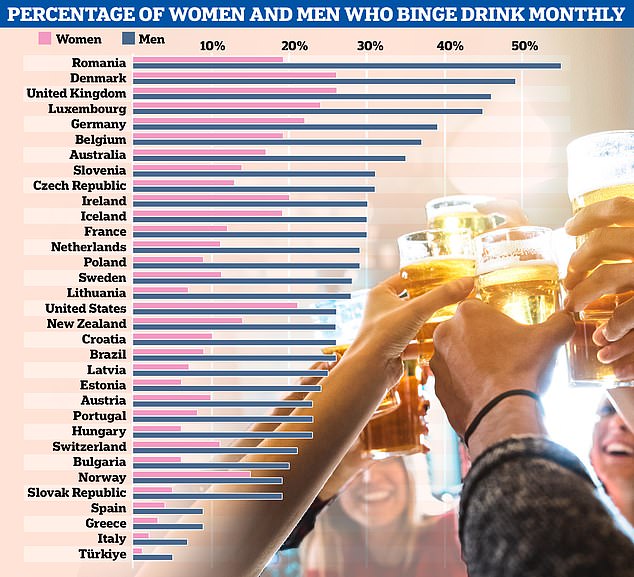Experts say women may be more likely to binge drink at certain times in their menstrual cycle, due to the spike in sex hormones.
Experiments found that the female hormone estrogen increases activity in a part of the brain that encourages rapid alcohol consumption.
Binge drinking was most likely to occur in the middle of the cycle, just before ovulation, when estrogen is highest.
While the study, conducted by researchers at Weill Cornell Medicine, was based on mice, the authors said it could have implications for preventing dangerous alcohol intake in women.
The discovery comes amid growing concern that pro-alcohol trends on social media specifically targeting women may be leading to serious liver disease and even deaths.
Official data shows that alcohol-related deaths in Britain are rising more rapidly among women than men. Between 2019 and 2022, the rate of such deaths per 100,000 people increased by 44 percent in women, with a smaller jump of 38 percent in men.
Last year, a report by the Organization for Economic Co-operation and Development revealed that one in four British women now binge drink at least once a month – the highest proportion of the 29 countries analysed.
More than a quarter also admit to having consumed six or more alcoholic drinks on a single occasion. more than double the average rate of 12 percent.
Experts have found that women’s hormone levels could be the reason why some are more vulnerable to excessive alcohol consumption than others.
In the new research, published in Nature Communications, scientists found that high levels of estrogen encouraged females to consume large amounts of alcohol in the first half hour after it was offered.
The experts identified this effect as an interaction between the hormone and cells in a part of the brain called the stria terminalis, which “lights up” when female rodents consume alcohol, encouraging them to continue drinking in rapid succession.
One of the authors, Dr. Kristen Pleil, an expert in pharmacology, said: “When a woman takes her first sip from a bottle containing alcohol, those neurons (brain cells) go crazy.”
But this effect was “even crazier” if a woman was in a high estrogen state.
Women’s estrogen levels naturally fluctuate throughout the menstrual cycle and become particularly high just before ovulation.
Dr. Pleil said the observation that estrogen could influence alcohol consumption made sense given that the hormone was already known to influence emotions.
‘Estrogen has very powerful effects on many behaviors, particularly in women. Therefore, it makes sense that it also modulates alcohol consumption,” he said.

Last year, a report by the Organization for Economic Co-operation and Development (OECD) revealed that one in four British women now binge drink at least once a month – the highest proportion of the 29 countries analysed.
The team is now investigating the exact signaling mechanisms between stria terminalis neurons that produce this reaction and also exploring whether the same system has a role to play in excessive alcohol consumption in men.
Dr Pleil said: “The whole infrastructure is also present in men, the estrogen receptors and the organization of the basic circuit.”
“The only difference will be the source of estrogen, which in men without it depends on the conversion of testosterone to estrogen in the brain.”
While the study has so far only been conducted in mice, the authors say it could one day lead to possible interventions to combat excessive alcohol consumption.
The authors said this could be similar to already approved cancer treatments that stop tumor growth by inhibiting estrogen.
The discovery comes after experts He recently sounded the alarm a ‘worrying’ rebound of alcohol-related deaths among middle-aged women.
While the trend has been emerging for years, experts have said Covid-era social restrictions likely exacerbated Britain’s drinking problem.
Dozens of surveys have also found that boredom, having more time to drink and anxiety fueled the increase in alcohol consumption during lockdowns in both sexes.
The exact amount of alcohol that can cause irreversible liver damage varies from person to person, depending on genetics, experience with alcohol, and weight.
But one shock study found that just 21 bouts of alcohol binge drinking over seven weeks (three binge episodes per week) were enough to cause symptoms of early-stage liver failure.
Binge drinking was defined as five beers, one bottle of wine, or five shots of hard liquor among men. For women, it was four or more drinks in two hours.


